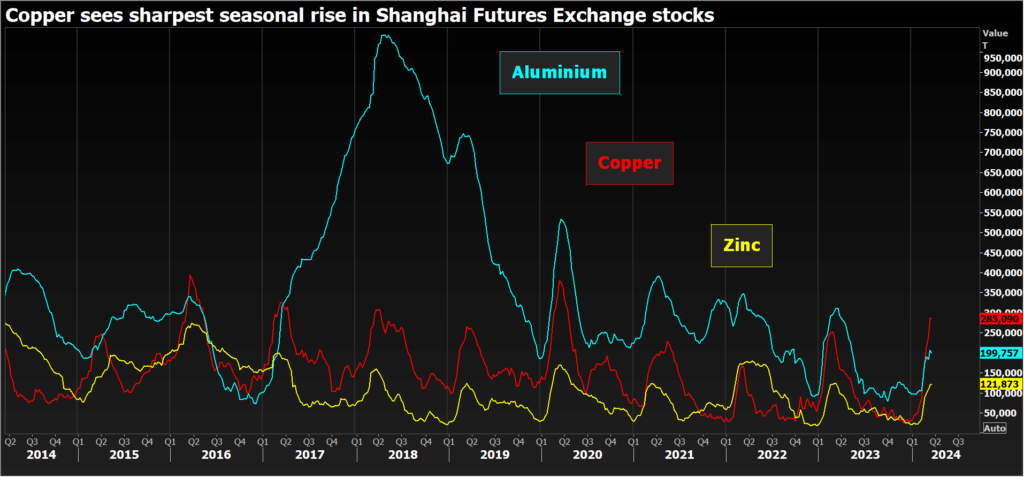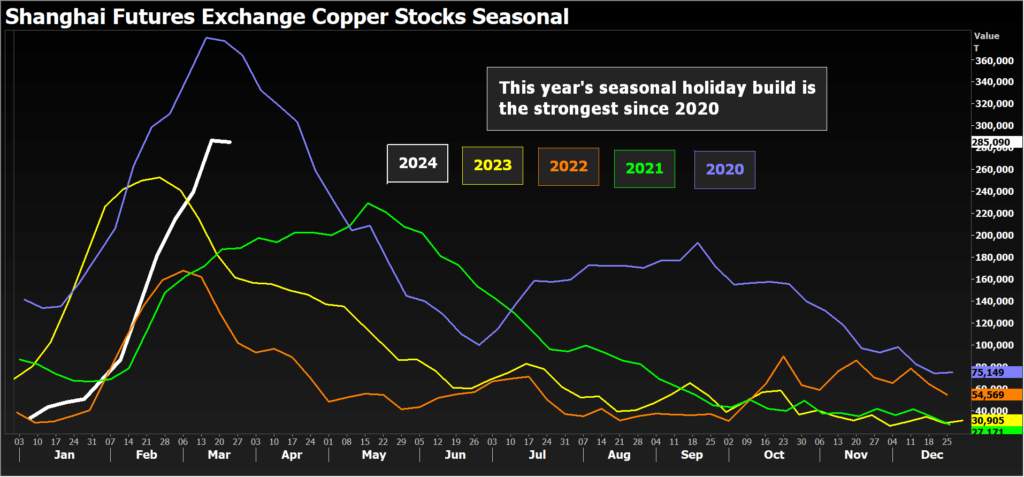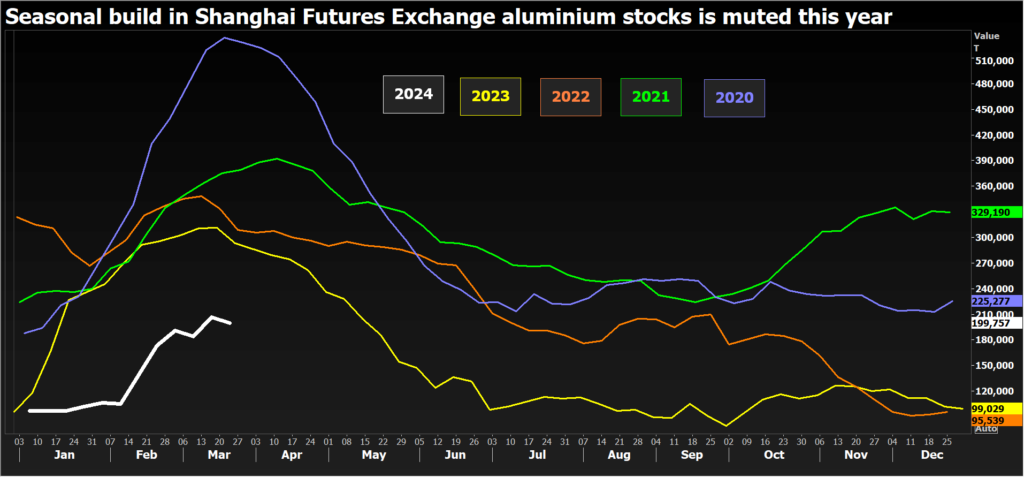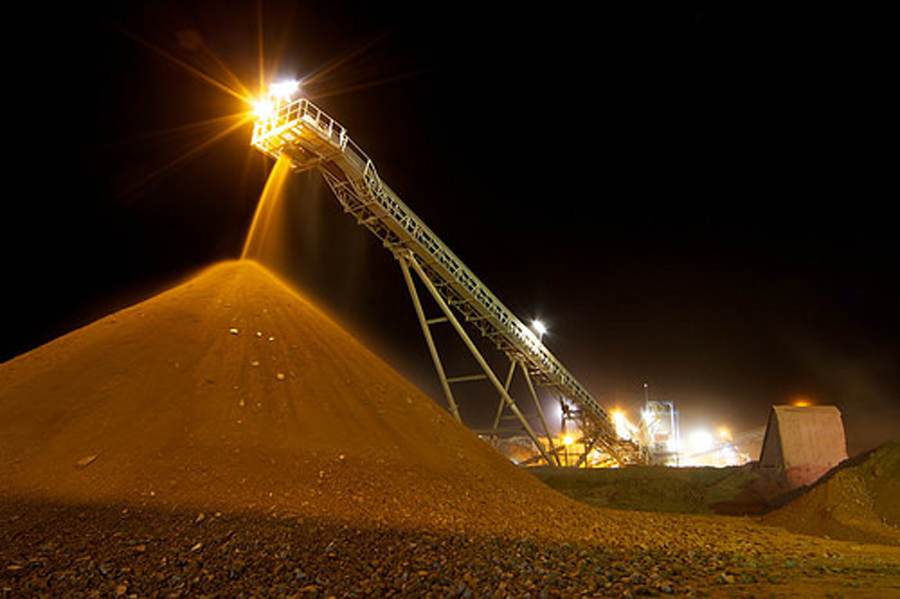Column: Copper registers strongest seasonal Shanghai stocks build

The Lunar New Year holiday surge in Shanghai Futures Exchange (ShFE) metal inventories seems to have peaked with registered stocks of copper, aluminum and lead all falling over the last week.
This is an annual phenomenon. While many metal fabricators take downtime over the holiday period, most smelters keep operating, leading to a jump in visible inventory.
Copper has experienced the sharpest seasonal stocks build this year, leaving exchange inventory at the highest levels since 2020.
The rise in ShFE zinc inventories has closely matched last year’s pattern, while aluminum has seen a highly muted rebuild by historical standards.
Nickel stocks were increasing before the holiday break and are now at four-year highs. Those of tin are the highest since ShFE launched its tin contract in 2015.

Copper surge
ShFE copper stocks have mushroomed from just 30,905 metric tons at the end of December to 285,090 tons.
The scale of this year’s seasonal surge has been the strongest since 2020, when registered inventory peaked at 380,085 tons. The New Year holiday period that year coincided with the first wave of COVID-19 lockdowns and the resulting slump in Chinese manufacturing activity.
This year the jump in exchange stocks likely reflects the combination of fast domestic production growth and higher imports.
The country’s output of refined copper rose by 9.0% year-on-year in January-February, equivalent to an extra 159,000 tons, according to local data provider Shanghai Metal Market. Imports rose by 2.6% over the same period.
Stocks registered with Shanghai’s International Energy Exchange have also jumped from 9,760 tons at the end of last year to a current 40,511 tons. However, this year’s mid-March peak of 45,298 tons fell short of last year’s peak of 82,575 tons.

Muted rise in aluminum stocks
ShFE stocks of aluminum fell to 199,757 tons this week from last week’s year-to-date high of 206,417 tons.
If that turns out to be this year’s seasonal peak, it means the rebuild has been extremely muted relative to the last four years.
Stocks are up by just 100,728 tons on the start of January. By this time last year they had risen by 229,000 tons. The seasonal effect was even stronger over the 2020-2022 period.
Visible inventory remains remarkably low after last year’s high imports of over 1.5 million tons and the bullish optics reinforce the narrative of a tight domestic market.

Seasonal norm for zinc and lead
Exchange stocks of zinc in Shanghai crept a little higher this week to 121,873 tons and are now up by 100,658 tons on the start of January.
This is very close to last year’s seasonal build of 103,441 tons and to that seen in 2021.
Shanghai lead stocks stand at 53,631 tons and are up by just 747 tons since the start of 2024, which is comparable to the 333-ton rise seen over the first three months of last year.
Lead is less exposed to the new year holiday effect, having its own seasonality in the form of car battery kill rates over the northern hemisphere winter months.
China is also exporting ever more refined lead. Shipments rose by 62% year-on-year to 188,000 tons in 2023, the highest annual volume since 2007.
The steady outbound flow has served to keep Shanghai inventory below the 100,000-ton level for the last two years.

Nickel stocks at four-year high
Shanghai nickel stocks dwindled to just 560 tons in May last year, reflecting a shift in domestic production from the refined nickel that trades on the ShFE to nickel sulphate used in electric vehicle batteries.
The dynamic has changed dramatically over the last year. A new generation of Chinese nickel refineries has started up to capitalise on the burgeoning import flow of Indonesian raw materials.
ShFE stocks have grown to 20,713 tons, the highest tally since December 2020. The build has been mirrored on the London market, where the London Metal Exchange (LME) has been fast-tracking Chinese companies wanting to list their brands. LME stocks have risen by 21% so far this year.
Tin stocks hit record high
Global exchange stocks of tin, by contrast, are showing divergent trends.
Those in London have fallen by a third this year to below 5,000 tons as supply is constrained by export delays in Indonesia.
Shanghai tin stocks have been rising steadily since the start of December and now total 12,021 tons, which is the highest inventory in the contract’s nine years of trading history.
The country has been stocking up on refined tin in recent months, imports hitting a record high of 33,470 tons last year.
(The opinions expressed here are those of the author, Andy Home, a columnist for Reuters.)
(Editing by David Evans)
Graphic: Congo overtakes Peru on copper output, still behind on exports
More News
{{ commodity.name }}
{{ post.title }}
{{ post.date }}



Comments